2016 - the hottest in the history of observations
Photo credit: Oxfam International via VisualHunt.com /CC BY-NC-ND
According to forecasts by the World Meteorological Organization (WMO), 2016 could be the hottest year in history. The global temperature broke the record in 2015. According to preliminary data, in 2016 the temperature by 1.2 degrees Celsius above pre-industrial levels. WMO draws our attention to climatic events, natural anomalies and disasters that affected our planet in 2016.
The air temperature increase
The average temperature around the world in January-September 2016 was about 1.2 degrees above pre-industrial levels and 0.88 degrees above the average temperature for the period 1961-1990. So far, all oriented to the meteorological indicators of this particular period: then, compared with the previous period, the average temperature for the year in the world has increased.
Global temperature change from the pre-industrial period to the present day
It was in the first months of 2016 particularly warm year: a record anomalies 1.12 degrees in February and 1.09 degrees in March. Re-analysis also shows that in October of abnormally high temperatures are similar to figures from May to September.
Graph of average temperature anomalies 1880-2016.
In most regions the temperature was higher than the average 1961-1990 years. In some northern regions of Russia around the mouth of the Ob River and the New Earth warmer by 6-7 degrees in the Arctic and sub-Arctic regions of Russia, Alaska and northwestern Canada - 3 degrees. If you look in the whole Northern Hemisphere, where the temperature rose by 1 degree. Less extreme pace of warming in the southern hemisphere occurs, although in some regions outside the tropics - South America, northern and eastern Australia, and most of Southern Africa - the figure is still higher than 1 degree.
Temperature anomalies worldwide (January-September 2016)
The only relatively large plot of land that hardly touched the abnormal warming - northern and central Argentina, Paraguay and part of Bolivia's lowlands. Here, the temperature below the average.
The rise in sea level and the melting of Arctic ice
Along with the land warms and the oceans: in most of its areas the temperature is above normal. This led to coral bleaching and disturbance of marine ecosystems in tropical waters. Among the victims - the Great Barrier Reef off the east coast of Australia and the Pacific island country of Fiji and Kiribati. In some areas of the Great Barrier Reef were lost up to 50% of corals. The temperature was below the norm by 1 degree or more can be seen in the waters of the Southern Ocean. This is particularly noticeable around the Drake Passage between South America and Antarctica.
Natural phenomenon of El Niño impact on the level of the oceans, in November 2014 - February 2016. During this time, the water level rose by about 15 millimeters. Since 1993, scientists have observed an annual rise of water in the 3-3.5 mm, but the value in 2016 reached new record highs.
The area of ice cover
Arctic ice continues to melt. The area of ice in September reached a seasonal low - 4.14 million km2. Since 2007, this is the second lowest. Winter peak in March was the lowest in history. Autumn freeze-up has also been much slower than usual. The length of the sea ice at the end of October is also a record low for this time of year.
Increasing concentrations of greenhouse gases in the atmosphere
The average annual concentration of carbon dioxide for the first time reached 400 parts per million units of volume (ppmv) in 2015. According to preliminary data, we can expect a new record in 2016. As an example, researchers give the situation at Cape Grim in Australia. Here, the level of CO2 in August 2015 amounted to 398,13 ppmv, and a year later, this figure has risen to the level of 401,2 ppmv. A similar situation occurred on the island of Mauna Loa, which is the eponymous volcano. The average weekly concentration of carbon dioxide in October 2015 amounted to 398,5 ppmv, and in October 2016 - has 402,07 ppmv. The highest monthly rate - 407,7 ppmv - was registered in May this year.
Devastating natural phenomena
Numerous natural events in 2016 had serious consequences for all mankind. The most significant in terms of the number of victims, researchers believe WMO Hurricane Matthew. According to the Government of Haiti in early November, as a result of the most powerful hurricane decade killed 546 people and injured 438. After Matthew walked across Haiti, traces found in the north. He went on to Cuba and the Bahamas, and then hit the US east coast. There's a hurricane triggered flooding Matthew off the coast of South Carolina.
Lionrock Typhoon (Typhoon Rinaldo) caused a devastating flood, and led to serious consequences in Japan, Korea and the Primorsky region of Russia. Cyclone Winston in Fiji has become the most destructive in the history of the island nation. A total of 78 tropical cyclones around the world were registered in 2016.
In the Yangtze River basin experienced the powerful summer floods that killed 310 people and brought damage at $ 14 billion. Missing or killed 200 people from floods and landslides in Sri Lanka in mid-May. Hundreds of thousands of people evacuated. Seasonal rainfall, coming beyond the norm in the Sahel, led to significant flooding in the Niger River Basin.
Southern African countries are affected by the drought 2015-2016
Throughout 2016 we have seen a number of heat waves. The year began with an extreme drought in southern Africa, adding to the already long drought. Meteorological stations record the new temperature records: 7 January temperature reached + 42,7 ° in Pretoria, + 38,9 ° in Johannesburg. Thailand has established an internal national record on April 28 - the temperature rose to + 44,6 °. May 19 in the Indian city of Phalodi documented record of + 51 °.
Record or near-record temperatures, meteorologists established in the Middle East and North Africa this summer. In Mitribahe (Kuwait) July 21 recorded the temperature 54 degrees, and the next day a new record - 53.9 degrees - established Basra (Iraq).
The most destructive wildfire in Canadian history occurred in May in Fort McMurray in Alberta. The fire destroyed 590 000 hectares of forest and became the most expensive natural disaster in Canada. Because he had to completely evacuate the city. Ultimately, the fire destroyed about 2,400 buildings and urban buildings.
Consequences and predictions
Annual and long-term changes in climate can exacerbate social, humanitarian and environmental pressures. Because of the frequent and devastating natural disasters, conflicts over dwindling resources and rising sea levels and flooding of lowlands, making them unfit for habitation, is expected to increase the population migration. According to the UN High Commissioner for Refugees, in 2015, 19.2 million registered movements, related to weather, climate and geophysical risks in 113 countries. South and East Asia dominates in terms of the highest absolute numbers, but no region of the world has been spared. What awaits us statistics on the results of 2016 are not yet known.
Extreme weather conditions and events related to climate change under the influence of El Niño 2015-2016, had a significant negative impact on agriculture and food security. The latter phenomenon has affected over 60 million people worldwide.
It is expected that 2017 will be hot, but most likely, new records this year will not be.
"El Niño is weakening, and we do not expect records from 2017. Perhaps in the coming year will be warmer than in any other year of the last two decades. Basically, this is due to increasing concentrations of greenhouse gases "- said Dr. Peter Scott from the UK Meteorological Office.
However, another analysis presented at the UN summit in Morocco, showed that after decades of steady growth in global carbon emissions in the past three years has increased slightly. The main reason for the overall stabilization of the situation, scientists believe China, which became burn less fossil coal.
WMO has published a preliminary statement for 2016. The final statement is expected in early 2017.
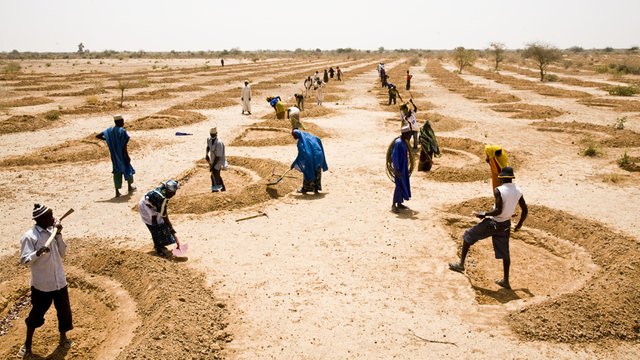
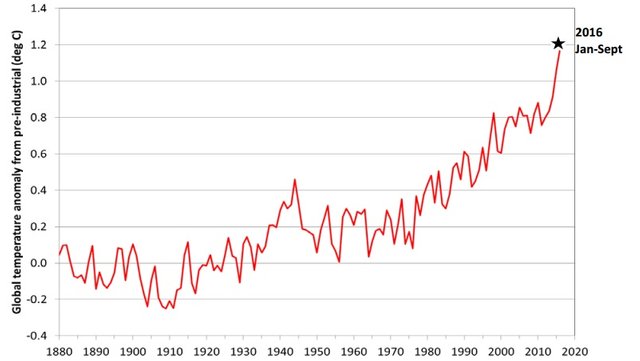
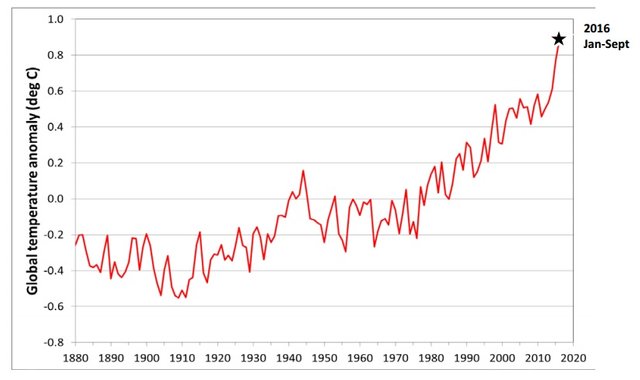
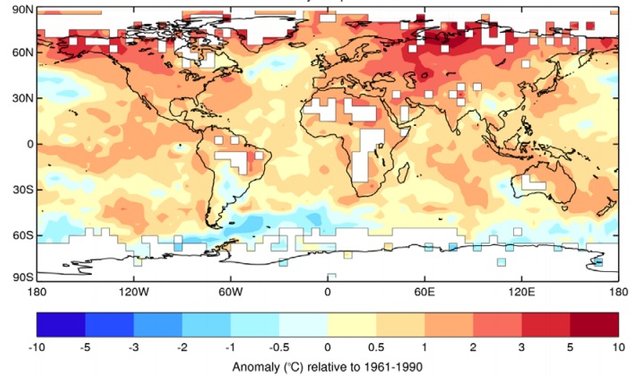
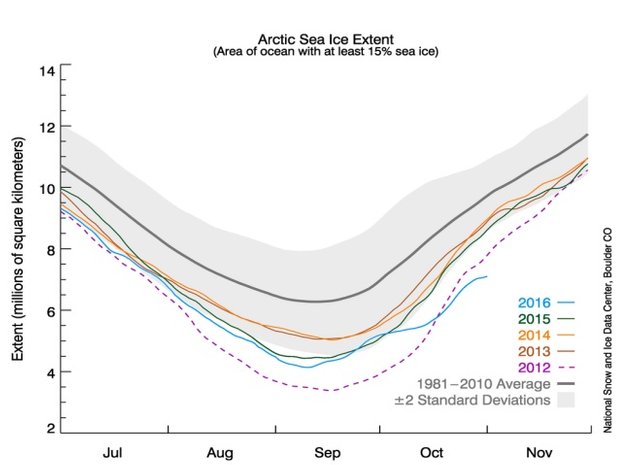
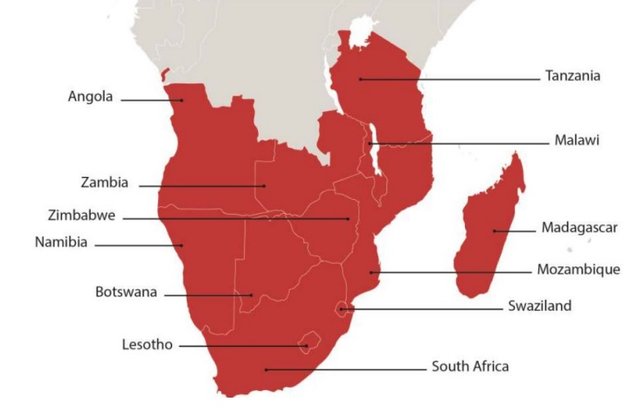
Join us on #steemSTEM
Very interesting observations on this interesting and important topic! In addition, it is well sourced and the presentation is great! Looking forward to more of your work!
This post has been ranked within the top 50 most undervalued posts in the first half of Nov 18. We estimate that this post is undervalued by $7.00 as compared to a scenario in which every voter had an equal say.
See the full rankings and details in The Daily Tribune: Nov 18 - Part I. You can also read about some of our methodology, data analysis and technical details in our initial post.
If you are the author and would prefer not to receive these comments, simply reply "Stop" to this comment.